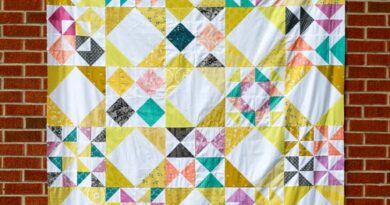Scrappy Four Patch Charm Quilt
Patchwork and handicrafts are an economical, creative, and noble way to make the items you need. For example, with EVA you can make flower arrangements, baby shoes, fake cakes for party decoration and children’s clothes. Among other materials that Yahweh Leather offers for creative work, we have chair covers, TNT, synthetic straw, acrylic blankets, Velcro fasteners, adhesives and contact glues. By definition, this is a craft technique used to produce items made from natural raw materials.
Craftsmanship is usually done at home, in houses, or in small workshops. It dates back to the Neolithic period, when early humans polished stones to make weapons and items for hunting and fishing, pottery to store food, and weaving to make hammocks, clothing and quilts. Where to start? Below, check out some of the possibilities available to start crafting your own artwork and materials!Patchwork and handicrafts, what is it? The term, in English, means patchwork. The technique consists of weaving quilts by joining fragments of various fabrics, using creative stitching. It can also be applied to the lining and making of pillows, bags, rugs, rag dolls, pouffes, sofa covers, and the customization of MDF trays and boxes, among others.
To begin, the technique requires some materials that, many times, we already have at home: rulers, scissors, compasses, stylet, thread, pencils, tape measure, needles, pins, cardboard, iron. It is important to be careful when storing cutting boards and rulers, which should always be kept flat to prevent warping, while scissors should be kept in a safe place (especially if you have children at home). Using the correct material makes all the difference in the final work: 100% cotton fabrics (tricoline is the most recommended) do not unravel much, are firmer than synthetics, and come in a huge variety of prints
Be aware of fabrics with elastane, because they lose elasticity over time and can disfigure your work, increasing disproportionately in size. It is made in three layers, which are joined by machine or hand seams. The top is the top, where the main decorative work is done with the patchwork; then comes the filling, which is in the middle and is what gives the patchwork its volume; and finally the lining, usually a one-piece fabric, which is at the bottom for finishing. Before you start, be sure to wash the fabric with mild soap and water and iron it before using it. This way, you are not caught by surprise with ink stains or shrinkage.
- Separate the scraps you will use and cut them into the shapes and sizes you prefer;
- Sew two pieces together at a time, either by hand or machine;
- Continue joining the pieces until you reach the size you have planned;
- Cut the filling and the lining 3 or 4 centimeters longer than the size of the top;
- Finally, join all the layers together.
TIPS – After you have taken a few classes and learned the best patchwork techniques, remember the tips below:
- Patterns, scratches and projects should be kept in a folder so they don’t get lost. Today’s work can be repeated tomorrow;
- Try to write down in a notebook the quantity, color of fabric and technique used in a work. Another option would be to put a small label on the back of the work with the piece’s data;
- Quilting thread and sewing machine thread should also be 100% cotton.
- Whenever you start a new quilt, always put a new needle in the machine. This will avoid small punctures from blunt needles, which can compromise your final work;
- When you finish making a piece, check all the work for stains, scratches, unthreaded threads, etc.
- Make a lining fabric bag to store your pieces in. This will keep it longer and will add value to your work if you wish to sell it.
PDF PATTERN FREE

SEE TOO : Fat Eighth Fruit Cake Quilt



